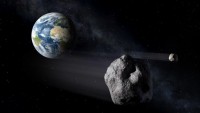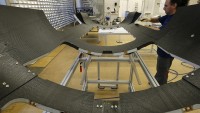Want to Join the China-Europe Robotic Space Mission?
| Vittorio Hernandez | | Jan 25, 2015 09:05 AM EST |
(Photo : Reuters) The Chinese Academy of Sciences (CAS) and the European Space Agency (ESA) have called for proposals for a robotic space mission that the two organizations will develop together and launch in 2021.
Scientists have until March 16, 2015, to submit their project proposals that would perform research on astronomy, solar system and fundamental physics under a planned joint robotic space mission that Europe and China would jointly launch in 2021.
The joint call made by the Chinese Academy of Sciences and European Space Agency (ESA) for proposals on Monday was the result of two workshops conducted in China and Denmark in 2014, reports Spaceflightnow.com.
Like Us on Facebook
The winning proposal would be selected in late 2015, while final go ahead signal for full development would be in 2017.
Proposals could tackle any subject in space science, except moon or Mars exploration since ESA's science program has a specific unit for those areas, explains Favio Favata, ESA's head of science planning and community coordination office.
Under the guidelines, every proposal must have a principal investigator from China and a member from an ESA country, with the scientific payload of the spacecraft to be jointly developed by members of the two teams.
There is a weight limit of 660 pounds, or 300 kilograms, and the design should be for a two- or three-year mission. The satellite payload, on the other hand, should be less than 132 pounds, or 60 kilograms.
In response to Washington's restrictions on high-tech equipment for military use on Chinese rocket launches, no sensitive U.S.-manufactured spacecraft parts that are under export control restrictions could be used. Manufacturing could be done in either Europe or China, while maximum cost is $56 million, or 50 million euro.
Lastly, the mission has four launch pads to select from. These are the European Vega booster, Soyuz rocket, Long March 2c or Long Match 2D launcher of China.
It is not the first collaboration between China and ESA since the two developed and launched in 2003 and 2004 two satellites for their Double Star mission that was used to measure processes in the Earth's magnetosphere and response to solar activity fluctuation of monitored magnetic bubble.
©2015 Chinatopix All rights reserved. Do not reproduce without permission
EDITOR'S PICKS
-

Did the Trump administration just announce plans for a trade war with ‘hostile’ China and Russia?
-

US Senate passes Taiwan travel bill slammed by China
-

As Yan Sihong’s family grieves, here are other Chinese students who went missing abroad. Some have never been found
-

Beijing blasts Western critics who ‘smear China’ with the term sharp power
-

China Envoy Seeks to Defuse Tensions With U.S. as a Trade War Brews
-

Singapore's Deputy PM Provides Bitcoin Vote of Confidence Amid China's Blanket Bans
-

China warns investors over risks in overseas virtual currency trading
-

Chinese government most trustworthy: survey
-

Kashima Antlers On Course For Back-To-Back Titles
MOST POPULAR
LATEST NEWS
Zhou Yongkang: China's Former Security Chief Sentenced to Life in Prison

China's former Chief of the Ministry of Public Security, Zhou Yongkang, has been given a life sentence after he was found guilty of abusing his office, bribery and deliberately ... Full Article
TRENDING STORY

China Pork Prices Expected to Stabilize As The Supplies Recover

Elephone P9000 Smartphone is now on Sale on Amazon India

There's a Big Chance Cliffhangers Won't Still Be Resolved When Grey's Anatomy Season 13 Returns

Supreme Court Ruled on Samsung vs Apple Dispute for Patent Infringement

Microsoft Surface Pro 5 Rumors and Release Date: What is the Latest?













